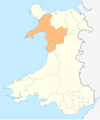Morfa Mawddach railway station
 | |
| Location | Arthog, Gwynedd Wales |
| Coordinates | 52°42′28″N 4°01′54″W / 52.7077°N 4.0316°WCoordinates: 52°42′28″N 4°01′54″W / 52.7077°N 4.0316°W |
| Grid reference | SH628142 |
| Managed by | Transport for Wales |
| Platforms | 1 |
| Other information | |
| Station code | MFA |
| Classification | DfT category F2 |
| History | |
| Original company | Aberystwith and Welsh Coast Railway |
| Pre-grouping | Cambrian Railways |
| Post-grouping | Great Western Railway |
| Key dates | |
| 3 July 1865 | Opened as Barmouth Junction |
| 13 June 1960 | Renamed Morfa Mawddach |
| Passengers | |
| 2016/17 | |
| 2017/18 | |
| 2018/19 | |
| 2019/20 | |
| 2020/21 | |
| Notes | |
Passenger statistics from the Office of Rail and Road | |
Morfa Mawddach railway station (formerly Barmouth Junction) is an unstaffed station located on the outskirts of the village of Arthog in Gwynedd, Wales, on the Cambrian Coast line between Machynlleth and Pwllheli. Built by the Aberystwith and Welsh Coast Railway in 1865, it was formerly the junction station for the Ruabon to Barmouth Line. Since the closure of the Ruabon to Barmouth line in 1965, it remains open, as a minor station on the Cambrian Line.
History[]

The station was built by the Aberystwith [sic] and Welsh Coast Railway and opened on 3 July 1865 as Barmouth Junction.[1][2] From 1899 to 1903 there was a connection with the Barmouth Junction and Arthog Tramway.
The station was host to a GWR camp coach from 1934 to 1939.[3][4] A camping coach was also positioned here by the Western Region from 1956 to 1962. In 1963 the administration of camping coaches at the station was taken over by the London Midland, there were three coaches here in 1963 and 1964 and two from 1965 to 1968.[5]
Until the 1960s there was a summer service between London Paddington and Pwllheli, via Birmingham Snow Hill, Shrewsbury and Machynlleth.
On 13 June 1960 it was renamed Morfa Mawddach.[2]
Background[]
North of Morfa Mawddach the railway crosses the Afon Mawddach on the Barmouth Bridge.
Morfa Mawddach is mainly used by passengers travelling to Barmouth from south of the Mawddach Estuary: parking at the station and taking the train to Barmouth is often much quicker than the 20-mile road journey via Dolgellau. Originally a four-platform station, it is now a single platform unstaffed halt. Trains stop on request.
Morfa Mawddach is often quoted as an example of a notable feature of the Great Western Railway in Wales, namely its inheritance of junctions in unlikely and inconvenient locations. Other examples are Moat Lane Junction, Talyllyn Junction, Afon Wen and Dovey Junction.[6]
The trackbed to Dolgellau now forms the Llwybr Mawddach (Welsh for 'Mawddach Trail'), which officially starts at the station car park.
Facilities[]
The station has very few facilities. There is a payphone on the platform, but there are no toilets or help points available. There is a small waiting shelter and a car park with 20 spaces.[7]
Services[]
| Preceding station | Following station | |||
|---|---|---|---|---|
| Fairbourne | Transport for Wales Cambrian Coast Line |
Barmouth | ||
| Historical railways | ||||
| Barmouth Line and station open |
Great Western Railway Aberystwith and Welsh Coast Railway |
Fairbourne Line and station open | ||
| Great Western Railway Aberystwith and Welsh Coast Railway |
Arthog Line and station closed | |||
References[]
Notes[]
- ^ Butt 1995, p. 27
- ^ a b Butt 1995, p. 163
- ^ McRae 1997, p. 31
- ^ Fenton 1999, p. 24
- ^ McRae 1998, pp. 112 & 120–123
- ^ Fifoot, Les; Wright, Paul (21 May 2017). "Station name: Afon Wen". disused-stations.org.uk. Retrieved 2 February 2020.
- ^ "National Rail Enquiries - Station facilities for Morfa Mawddach".
Sources[]
- Butt, R. V. J. (1995). The Directory of Railway Stations: details every public and private passenger station, halt, platform and stopping place, past and present (1st ed.). Sparkford: Patrick Stephens Ltd. ISBN 978-1-85260-508-7. OCLC 60251199.
- Fenton, Mike (1999). Camp Coach Holidays on the G.W.R. Wild Swan. ISBN 1-874103-53-4.
- McRae, Andrew (1997). British Railway Camping Coach Holidays: The 1930s & British Railways (London Midland Region). Scenes from the Past: 30 (Part One). Foxline. ISBN 1-870119-48-7.
- McRae, Andrew (1998). British Railways Camping Coach Holidays: A Tour of Britain in the 1950s and 1960s. Scenes from the Past: 30 (Part Two). Foxline. ISBN 1-870119-53-3.
Further reading[]
- Jowett, Alan (March 1989). Jowett's Railway Atlas of Great Britain and Ireland: From Pre-Grouping to the Present Day (1st ed.). Sparkford: Patrick Stephens Ltd. ISBN 978-1-85260-086-0. OCLC 22311137.
- Jowett, Alan (2000). Jowett's Nationalised Railway Atlas (1st ed.). Penryn, Cornwall: Atlantic Transport Publishers. ISBN 978-0-906899-99-1. OCLC 228266687.
- Mitchell, Vic; Smith, Keith (2010). Ruabon to Barmouth. Midhurst, West Sussex: Middleton Press. figs. 107-116. ISBN 9781906008840. OCLC 651922152.
External links[]
| Wikimedia Commons has media related to Morfa Mawddach railway station. |
- Train times and station information for Morfa Mawddach railway station from National Rail
- Past and present photos of Morfa Mawddach station
- Railway stations in Gwynedd
- Former Cambrian Railway stations
- Railway stations in Great Britain opened in 1865
- Railway stations served by Transport for Wales Rail
- Railway request stops in Great Britain
- Rail junctions in Wales
- Arthog
- 1865 establishments in Wales

